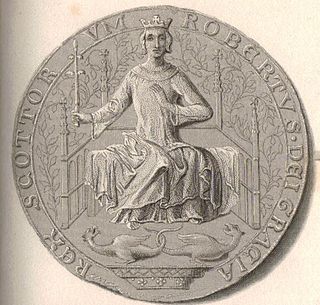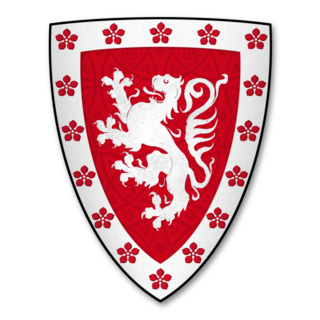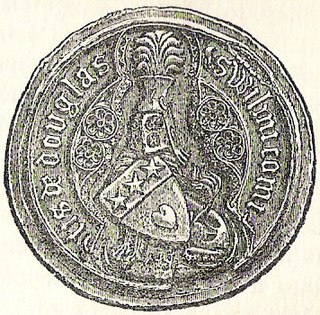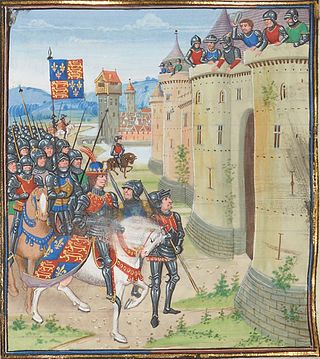Related Research Articles

The Wars of Scottish Independence were a series of military campaigns fought between the Kingdom of Scotland and the Kingdom of England in the late 13th and early 14th centuries.

Robert II was King of Scots from 1371 to his death in 1390. The son of Walter Stewart, 6th High Steward of Scotland, and Marjorie, daughter of King Robert the Bruce, he was the first monarch of the House of Stewart. Upon the death of his uncle David II, Robert succeeded to the throne.

Sir James Douglas was a Scottish knight and feudal lord. He was one of the chief commanders during the Wars of Scottish Independence.

Patrick de Dunbar, 9th Earl of March, was a prominent Scottish magnate during the reigns of Robert the Bruce and David II.

Dryburgh Abbey, near Dryburgh on the banks of the River Tweed in the Scottish Borders, was nominally founded on 10 November (Martinmas) 1150 in an agreement between Hugh de Morville, Constable of Scotland, and the Premonstratensian canons regular from Alnwick Abbey in Northumberland. The arrival of the canons along with their first abbot, Roger, took place on 13 December 1152.

Thomas Randolph, Earl of Moray was a soldier and diplomat in the Wars of Scottish Independence, who later served as regent of Scotland. He was a nephew of Robert the Bruce, who created him as the first earl of Moray. He was known for successfully capturing Edinburgh Castle from the English, and he was one of the signatories of the Declaration of Arbroath.
Walter Stewart was the 6th Hereditary High Steward of Scotland and was the father of King Robert II of Scotland, the first Stewart monarch.
Sir Alexander Ramsay of Dalhousie was a Scottish nobleman and knight who fought for David II, King of Scots in the south of Scotland in the Second War of Scottish Independence. He is remembered especially for his actions during the siege of Roxburgh Castle.
The Raid of the Redeswire, also known as the Redeswire Fray, was a border skirmish between England and Scotland on 7 July 1575 which took place at Carter Bar, the Cheviot pass which enters Redesdale. The skirmish was between the English Warden of the Middle Marches, Sir John Forster, with Sir George Heron, Keeper of Redesdale, Keeper of Liddesdale and Scottish Warden and Sir John Carmichael, the Lord Warden of the Marches, with George Douglas of Bonjedworth. It was the last battle between the Kingdom of England and the Kingdom of Scotland.

Berwick Castle is a ruined castle in Berwick-upon-Tweed, Northumberland, England.

William Douglas, 1st Earl of Douglas was a Scottish nobleman, peer, magnate, and head of the Black Douglas family. Under his leadership, the Black Douglases continued their climb to pre-eminence in Scottish politics begun under his uncle, Sir James the Good, as well as their military dominance of the south of Scotland.
Sir Archibald Douglas was a Scottish nobleman, Guardian of Scotland, and military leader. He is sometimes given the epithet "Tyneman", but this may be a reference to his great-nephew Archibald Douglas, 4th Earl of Douglas. He fought and died at the Battle of Halidon Hill.

Sir William Douglas "le Hardi", Lord of Douglas was a Scottish nobleman and soldier.

Sir William Douglas, Lord of Liddesdale, also known as the Knight of Liddesdale and the Flower of Chivalry, was a Scottish nobleman and soldier active during the Second War of Scottish Independence.

The Battle of Teba took place in August 1330, in the valley below the fortress of Teba, now a town in the province of Málaga in Andalusia, southern Spain. The encounter occurred during the frontier campaign waged between 1327 and 1333 by Alfonso XI of Castile against Muhammed IV, Sultan of Granada.

The Auld Alliance was an alliance between the kingdoms of Scotland and France against England made in 1295. The Scots word auld, meaning old, has become a partly affectionate term for the long-lasting association between the two countries. The alliance was never formally revoked, although it is considered by some to have ended with the signing of the Treaty of Edinburgh in 1560.
In July 1482 an English army invaded Scotland during the Anglo-Scottish Wars. The town of Berwick-upon-Tweed and its castle were captured and the English army briefly occupied Edinburgh. These events followed the signing of the Treaty of Fotheringhay, 11 June 1482, in which Alexander Stewart, Duke of Albany, the brother of James III of Scotland declared himself King of Scotland and swore loyalty to Edward IV of England. The follow-up invasion of Scotland under the command of Edward's brother, Richard, Duke of Gloucester failed to install Albany on the throne, but Berwick has remained English ever since the castle surrendered on 24 August. The English army left Edinburgh with a promise for the repayment of the dowry paid for the marriage of Princess Cecily of England to the Scottish Prince.
The Battle of Nesbit Moor was an engagement fought in August 1355 between forces of the Kingdom of Scotland and the Kingdom of England.
Edmond de Caillou or Raymond de Caillou was a Gascon knight who fought during the First War of Scottish Independence.

The siege of Berwick lasted four months in 1333 and resulted in the Scottish-held town of Berwick-upon-Tweed being captured by an English army commanded by King Edward III. The year before, Edward Balliol had seized the Scottish Crown, surreptitiously supported by Edward III. He was shortly thereafter expelled from the kingdom by a popular uprising. Edward III used this as a casus belli and invaded Scotland. The immediate target was the strategically important border town of Berwick.
References
- ↑ David Hume, David Reid (1996), The history of the house of Douglas, p. 488